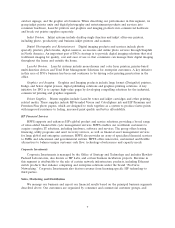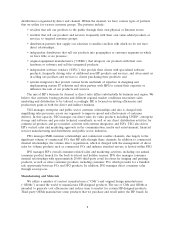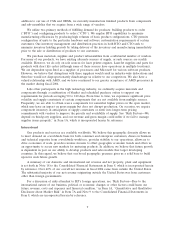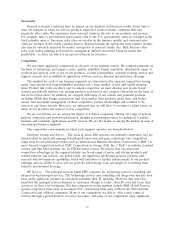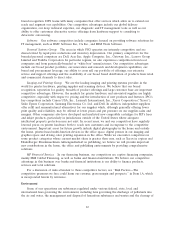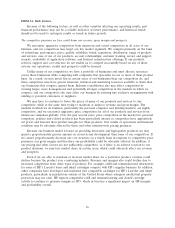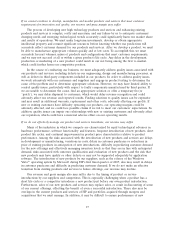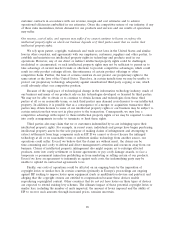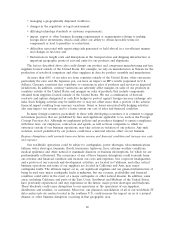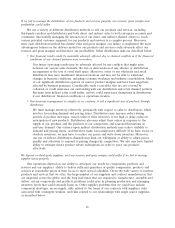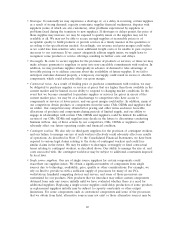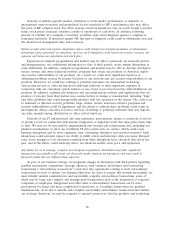HP 2006 Annual Report Download - page 21
Download and view the complete annual report
Please find page 21 of the 2006 HP annual report below. You can navigate through the pages in the report by either clicking on the pages listed below, or by using the keyword search tool below to find specific information within the annual report.If we cannot continue to develop, manufacture and market products and services that meet customer
requirements for innovation and quality, our revenue and gross margin may suffer.
The process of developing new high technology products and services and enhancing existing
products and services is complex, costly and uncertain, and any failure by us to anticipate customers’
changing needs and emerging technological trends accurately could significantly harm our market share
and results of operations. We must make long-term investments, develop or obtain appropriate
intellectual property and commit significant resources before knowing whether our predictions will
accurately reflect customer demand for our products and services. After we develop a product, we must
be able to manufacture appropriate volumes quickly and at low costs. To accomplish this, we must
accurately forecast volumes, mixes of products and configurations that meet customer requirements,
and we may not succeed at all or within a given product’s life cycle. Any delay in the development,
production or marketing of a new product could result in our not being among the first to market,
which could further harm our competitive position.
In the course of conducting our business, we must adequately address quality issues associated with
our products and services, including defects in our engineering, design and manufacturing processes, as
well as defects in third-party components included in our products. In order to address quality issues,
we work extensively with our customers and suppliers and engage in product testing to determine the
cause of the problem and to determine appropriate solutions. However, we may have limited ability to
control quality issues, particularly with respect to faulty components manufactured by third parties. If
we are unable to determine the cause, find an appropriate solution or offer a temporary fix (or
‘‘patch’’), we may delay shipment to customers, which would delay revenue recognition and could
adversely affect our revenue and reported results. Finding solutions to quality issues can be expensive
and may result in additional warranty, replacement and other costs, adversely affecting our profits. If
new or existing customers have difficulty operating our products, our operating margins could be
adversely affected, and we could face possible claims if we fail to meet our customers’ expectations. In
addition, quality issues can impair our relationships with new or existing customers and adversely affect
our reputation, which could have a material adverse effect on our operating results.
If we do not effectively manage our product and services transitions, our revenue may suffer.
Many of the industries in which we compete are characterized by rapid technological advances in
hardware performance, software functionality and features, frequent introduction of new products, short
product life cycles, and continual improvement in product price characteristics relative to product
performance. Among the risks associated with the introduction of new products and services are delays
in development or manufacturing, variations in costs, delays in customer purchases or reductions in
price of existing products in anticipation of new introductions, difficulty in predicting customer demand
for the new offerings and effectively managing inventory levels so that they are in line with anticipated
demand, risks associated with customer qualification and evaluation of new products and the risk that
new products may have quality or other defects or may not be supported adequately by application
software. The introduction of new products by our suppliers, such as the release of the Windows
Vista operating system by Microsoft during HP’s first fiscal quarter of 2007, also may result in delays
in customer purchases and difficulty in predicting customer demand. If we do not make an effective
transition from existing products and services to future offerings, our revenue may decline.
Our revenue and gross margin also may suffer due to the timing of product or service
introductions by our suppliers and competitors. This is especially challenging when a product has a
short life cycle or a competitor introduces a new product just before our own product introduction.
Furthermore, sales of our new products and services may replace sales, or result in discounting of some
of our current offerings, offsetting the benefit of even a successful introduction. There also may be
overlaps in the current products and services of HP and portfolios acquired through mergers and
acquisitions that we must manage. In addition, it may be difficult to ensure performance of new
17


